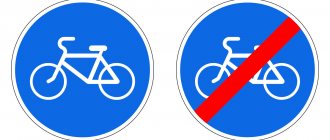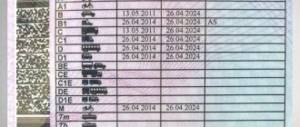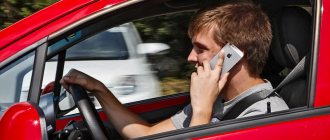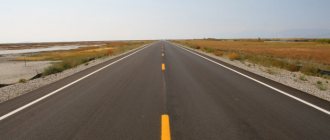General traffic rules for cyclists
The basic provisions of the riding rules for cyclists are set out in Article 24 of the Traffic Regulations, but this is not the only mention of two-wheeled vehicles in the laws. Since 2014, the concept of “bicycle path” has appeared in the rules, and ideally, citizens using this type of transport should only ride along it (Article 24.1 of the Traffic Rules) and always move onto it if one appears in their field of vision. But in fact, they are only in large cities, like Moscow or St. Petersburg, and then on busy avenues. How to cope with this problem for residents of residential areas and small provincial towns will be discussed below.
According to Article 2.3 of the Traffic Regulations, before leaving, the bicycle driver must ensure that his vehicle is fully prepared for the trip: it has working brakes, steering wheel, chassis, inflated wheels, working light signals and a bell.
It is necessary to wear protective equipment such as a helmet or knee and elbow pads. There is no legal obligation for either children or adults to wear these things, and there will be no punishment for their absence, but elementary safety considerations have not been canceled. It is better to cover your eyes with special sports sunglasses.
Should he follow traffic rules?
A bicycle is officially equated to a type of vehicle and, for traffic regulations, is not much different from a car. For this two-wheeler, all the rules that begin with “The driver must…”, “The vehicle must…”, etc. apply. A bicycle does not belong to a mechanical vehicle, so if the test is about them, then it is not for cyclists.
For violations of traffic rules, the cyclist will bear administrative responsibility on an equal basis with other road users.
Expert opinion
Evgeniy Romanov
Lawyer, specializes in protecting rights in areas related to traffic rules, insurance and disputes with the traffic police.
There is a nuance that applies only to this type of transport: if a person gets off the saddle and stands on his feet, then officially he is already a pedestrian and obeys the rules for pedestrians.
Rules for cyclists
There are not so many special traffic rules specifically for cyclists and they are not as strict as for cars, but they still must be followed, especially if you ride a bicycle along country roads.
Along the roadway
The rules for driving on the roadway are regulated in Article 24.2 of the Traffic Regulations. They indicate that you can move along the highway only if there is no special bicycle path nearby or for some reason it is impossible to travel along it. The cyclist must stay strictly at the right edge of the route in the direction of flow, without driving over the strip that separates the road from the side of the road (solid line 1.2.1 or broken line 1.2.2).
When approaching a pedestrian crossing, he must slow down, let people pass and move on, just like cars.
You can also drive on the road if the vehicle has dimensions of more than one meter or is traveling with a trailer whose width is more than one meter. When a whole column of bicycles follows the road, it is permissible for it to move only in one row. You can travel in two columns as an exception if:
- The width of a bicycle with a driver is no more than 0.75 meters;
- No more than ten vehicles are moving;
- Groups with more than ten bicycles must travel in several groups of ten participants. To make overtaking easier, they should stretch out at a distance of 80-100 meters from each other.
The rules do not oblige a cyclist to move off the asphalt onto the dirt shoulder to let passing traffic pass. Motorists must understand that a bicycle is a road user like them, and not a pedestrian.
On the side of the road
According to the traffic rules, you can ride on the side of the road on the right side of the road in the direction of travel if there are no specially designated bicycle paths, sidewalks, pedestrian zones or there is an obstacle to driving along the right edge of the highway.
On the sidewalk or pedestrian path
You can ride on the sidewalk or in the pedestrian zone, if, again, there is no special bicycle path nearby and it is not possible to ride along the right edge of the highway. You also need to move exclusively on the sidewalk if a cyclist under 14 years of age is riding nearby or when transporting a child under 7 years of age in a specially adapted seat or in a stroller. A child under 7 years old must also ride a bicycle exclusively on the sidewalk, accompanied by adult pedestrians.
Paths and lanes for cyclists
Bicycle paths are lanes that are specifically designated in large cities for cycling. Ideally, cyclists should only ride on it. Riding on the sidewalk, in a pedestrian zone, on a highway and in other places not suitable for bicycles, if there is a bicycle path, is prohibited.
A bicycle path is a narrow strip with asphalt surface. Nearby there is a road sign 4.4 “Bicycle path”, or the sign is depicted directly on the asphalt. They come in both one-way and two-way traffic.
How to pass intersections on a bicycle?
The rules for driving through intersections are set out in Article 13 of the Traffic Regulations. If it is not regulated by a traffic light or a traffic controller and is equivalent, then priority in the turn will always go to the one on the right. If the road is uneven (that is, there is a sign 2.1 “Main Road”), then the one moving along the main road goes first. Vehicles on a secondary road allow a car to pass to the right of it.
This does not apply to trams - they always have priority.
If there is a traffic light or a traffic controller, then you need to obey their signals. According to Article 24.8 of the Traffic Rules, a bicycle is prohibited from turning left if the road has more than one lane. He can only move forward and to the right. If he needs to turn left, he will have to dismount and look for a pedestrian crossing to the other side of the highway.
Unfortunately, some drivers are not aware that a cyclist is a participant in the traffic just like himself, and may treat two-wheeled vehicles with disdain. This is a serious misconception.
To avoid exposing himself to unnecessary danger from ignorant drivers, it is best for a cyclist to stop in his lane and patiently wait for other road users to make their maneuver, and only when the road is clear, cross the road himself.
Maximum speed
The cyclist must adhere to the same speed limit that is indicated on the sign for all road users (clause 10.1 of the traffic rules). As a rule, in urban areas the maximum speed limit is 60 km/h; in courtyards and residential areas you cannot drive faster than 20 km/h. If it is almost impossible to exceed the first indicator on a bicycle, then breaking the second is not difficult. On the road you can find even fewer speed limits - all of them are mandatory.
If the bicycle has an electric drive, then at around 25 km/h it should turn off.
Outside the city, the speed limit is, as a rule, beyond the reach of muscle-powered vehicles, so when riding on a country road it is almost impossible for a cyclist to break the speed limit.
Traffic lights and intersections
A two-wheeled vehicle moving along a highway is one of the participants in the movement. Accordingly, at intersections controlled by traffic lights, cyclists are subject to the same rules as motorists. A cyclist has no right to drive beyond the limit line, run through a prohibiting traffic light, or turn around. He should stop before the intersection and wait until the entire column receives the permission signal.
Maneuvering signals and lighting devices
In accordance with Article 8.1 of the Traffic Regulations, a vehicle is required to give signals to start moving, turn, change lanes, brake and stop. Unlike cars, bicycles are not equipped with lights, and the rules require cyclists to signal with their hands when maneuvering.
Nobody forbids installing special equipment with light signals on a bicycle. This way you can significantly facilitate your own movement on the roads.
- Turn left: extend your left arm to the side, or bend your right arm at a right angle and move it to the side;
- Turn to the right: extend your right arm to the side, or bend your left arm at a right angle and move it to the side;
- Stop: raise your left or right hand up.
All these signals should be followed a couple of seconds before starting the maneuver. It is important that other road users can see your sign and react in advance. After the signal is given and you are sure that the drivers have had enough time and opportunity to see it, you can return your hand to the steering wheel and turn.
Avoid performing these signals along with braking with one hand on the handlebars to avoid being thrown out of the saddle.
If the driver of a vehicle moves in the dark, then according to Article 19.1 of the Traffic Regulations, he must have reflective elements with him. For cyclists - reflectors and a flashlight. The white reflector needs to be attached to the front along with the flashlight on, and the red one to the back. It's also a good idea to have reflectors on wheels and wear a jacket with reflective stickers.
Article 19.5 imposes an obligation on drivers to turn on their lights during daylight hours to indicate traffic on the highway. In theory, this also applies to bicycles, but in fact this is not observed on the roads.
For cyclists under 14 years of age
Cyclists under 14 years of age must travel exclusively on the sidewalk or bike path, and only within pedestrian zones. There should not be a situation on the road where a child is driving on the road and his parent is driving on the sidewalk. And vice versa is also prohibited.
On country roads, where there is neither a bike path nor a pedestrian zone, children under 14 years of age are not allowed to ride bicycles, no matter whether there is an adult nearby or not.
A child under 7 years old on a bicycle must be accompanied by adult pedestrians on sidewalks or pedestrian paths. You cannot accompany him on your own bicycle either.
CYCLIST on a PEDESTRIAN CROSSING
Lecture on a legal topic for drivers, teachers, driving school students and their parents!
And then the children switch from scooters and skateboards, some to bicycles, some to scooters or mopeds. How this could end is our article.
Road traffic changes over the years. Cars, morals and education are changing. Here is a striking example from today. Drivers I know have already told me about this phenomenon, which, if not stopped, will multiply, multiply, and become ubiquitous. What we are talking about is that cyclists on bicycles began to cross the road at a pedestrian crossing, like this, they ride along the sidewalk, and then turn and, without getting off the bicycle, cross the roadway at the pedestrian crossing.
The topic of this article was determined by the fact that an accident occurred due to the fact that a cyclist with a passenger on the frame tried to cross the road at a pedestrian crossing while making a left turn on a four-lane road with a median. The cyclist drove onto the road dangerously close to an approaching KAMAZ truck. As a result, the cyclist died, the passenger was injured and was taken to the hospital. We will make a legal assessment of the actions of the participants in the accident, whose actions were a prerequisite for the tragedy. The first and most obvious observation is that the teenagers were left to their own devices, with no control from their parents. They rode their bikes everywhere they could and everywhere they couldn’t. They did not know the traffic rules at all, and naturally, they did not comply with them. It is depressing and alarming that people with a special legal education believe that drivers of all vehicles must give way to everyone who is at a pedestrian crossing, including cyclists. Many drivers also doubt what to do in such a situation. Our task is to answer two main questions.
First question. Is cycling allowed on an unregulated pedestrian crossing?
ANSWER: No. Forbidden. The pedestrian crossing is intended for pedestrian traffic only. The pedestrian crossing is not intended for vehicles to cross it. Let us turn to Chapter 1-GENERAL PROVISIONS, “Bicycle” is a vehicle, other than wheelchairs, that has two or more wheels and is driven by the muscular power of the people on it. The concept of “Driver” includes persons driving all types of vehicles, including bicycles, mopeds…. Consequently, the basic requirements for vehicle drivers set out in all sections of the Rules apply equally to drivers of BICYCLES and MOPEDS.
Clause-1.5. Traffic rules of the Republic of Kazakhstan. Road users are required to know and comply with the relevant requirements of the Rules, traffic lights or traffic controller signals, road signs and markings, as well as comply with the requirements of internal affairs officers.
Clause-1.6. Road users must act in such a way as not to create danger or harm. These are the fundamental points of the Rules that determine the rules of traffic, which apply equally to all road users, drivers, passengers and pedestrians.
SECOND QUESTION: What are the requirements of the TRAFFIC RULES. R.K. Should participants in road accidents take guidance? And whose actions caused the emergency that escalated into an accident...
Bicycle drivers must be guided by section 24. SDA.RK. Clause 24-3. “The driver of a bicycle is prohibited from turning left or making a U-turn on roads... that have more than one lane for traffic in a given direction.”
On such roads, drivers of bicycles and mopeds, in order to turn left or make a U-turn, must get off the bicycle and cross the road at a pedestrian crossing in accordance with paragraph 3.5 of the Traffic Rules. RK. Driving a bike nearby.
Clause 24.3. “It is prohibited to transport passengers, except a child under 7 years old, on an additional seat equipped with reliable footrests”
Clause-24.2. “Bicycles and mopeds should only move in the far right lane in one row as far to the right as possible.”
All of the listed points of the rules were ignored and violated by the cyclist.
Let's start with the latter, cyclists must move in the far right lane, and as far to the right as possible; the comments state that they must move no further than 1 meter from the right edge of the road. The cyclist moved exactly the opposite way, along the far left lane of the roadway. Moreover, carrying a passenger on the frame of a bicycle who is not seven years old, but twice as old. Instead of getting off his bike and crossing the road as a pedestrian, he immediately, without stopping, literally jumped onto the roadway in front of an approaching truck. The stopping distance of a road train at a speed of 50 km/h is more than 50 meters.
The truck driver must be guided primarily by paragraph 10.1. The driver must drive the vehicle at a speed not exceeding the established speed limit, taking into account all relevant factors... If a traffic hazard arises, WHICH THE DRIVER IS ABLE TO DETECT!!! The driver must take measures to reduce speed until the vehicle stops.
The key phrase in this formulation is a danger to movement and is able to detect. Let's remember the term “Traffic Hazard” - this is a sudden change in traffic that threatens its safety and requires a change in speed and (or) maneuvering of the vehicle. The situation was aggravated by the fact that the pedestrian speed is 5-6 km/hour . And the cyclist’s speed is twice as high, that is, 10-15 km/hour. Therefore, the truck driver had no physical ability to detect the danger. And especially the technical ability to stop the car.
A traffic hazard may be posed by an object on the road, for example. Fallen cargo, unclosed hatch, pedestrian. A car or other vehicle that found itself in the path of a vehicle involved in an accident, DUE TO ITS DRIVER'S VIOLATION OF TRAFFIC RULES! This is how the term traffic hazard is interpreted. The cyclist posed a danger to traffic primarily because his speed was twice as high as that of an ordinary pedestrian and his movement, in this case at a pedestrian crossing, was more difficult to control. And most importantly, all the actions of the cyclist are a consistent chain of violations of the traffic rules, which ultimately led to the tragedy. Nothing happens by chance, everything in life is interconnected. Violation is followed by punishment, sometimes the price of a mistake is human life.
To summarize: dear parents, you have decided to buy your child a bicycle and then a moped. Make sure that your son or daughter is familiar with the basic rules of safe driving of a two-wheeled vehicle. And check how they have learned these Rules. And try, if possible, to control where and how they ride . Happy New Year and be safe.
Enroll in a driving school where you will gain knowledge and skills and will actually teach you how to drive a car. And they won’t just issue a certificate of “successful” completion of a driving school. After which you will come to US and complete your studies, but for different money. no need to pay twice, do YOU need it? No, of course not, come to study with us and we will teach you how to drive a car safely, and you will be convinced that students come to us not because of false advertising, but on the recommendation of students who studied with us, and we are already teaching the 3rd generation of drivers . Come to us in the evening and see how many students we have. This is the best advertising when people trust us. And while reading our site, compare it with other similar publications and everything will be clear to YOU who is WHO. I will NOT translate this into English, because it will not be entirely euphonious. Read our website, we are sure that it will be useful for you. Come, we are always glad to see you.
Bye, see you again!!! And Merry Christmas.
15, total, today
Also interesting for you!
Car and environment
Overtaking: DANGER BY GOOD WILL or UNSURE DO NOT OVERTAKE
THREE RULES OF DRIVING SKILL
The latest generation car simulator is a reliable assistant in learning to drive a car.
Women's Auto Club
Calendar for drivers Poems for drivers! Poetry and safety go and go side by side...
← Previous post
Next entry →
Leave a comment Cancel reply
Cyclist privileges
Recently, cyclists have received an advantage: they are allowed to move in a dedicated lane for route vehicles. Such roads are indicated by blue road signs (5.11, 5.13.1, 5.13.2, 5.14). Apart from passenger taxis, school buses and bicycles, no type of transport is allowed to appear on it. However, there is a nuance: a cyclist can only enter it if it is located on the right and there are no bicycle paths nearby.
Cyclists are prohibited
- Driving a vehicle without hands on the steering wheel - reckless driving and driving with just your legs are unacceptable;
- Drive with a load that extends beyond the dimensions by more than 0.5 meters in any direction or interferes with control;
- Transport passengers on a frame, on a trunk or in any other way that is not provided for by the design;
- Transport a child without a specially equipped seat;
- Drive along pedestrian crossings;
- While in the right traffic, turn around or turn left on tram lines, or on a highway with two or more lanes - unless there is a special sign on the road allowing a turn or if the road does not pass in a special bicycle zone;
If you urgently need to turn left, you can get off your bike and, like an ordinary pedestrian, cross to the other side of the road along the zebra crossing, driving traffic nearby.
- Tow another bicycle (if there is no special towing trailer on which another vehicle is securely attached);
- Drive on highways;
- Talk on the phone while holding the steering wheel with one hand.
Where to go?
Which side should cyclists ride on? This is a rather controversial issue among bicycle drivers: some argue that you need to move in the direction of travel, some prefer to ride “against the grain,” and others do not think about this issue at all. Who is right?
The traffic rules clearly and clearly define the correct position of a bicycle: in the same direction as other vehicles, but to the right. For example, along the edge of the road or in the right lane in case of multi-lane traffic.
The traffic rules also determined that riding cyclists over 14 years of age is possible in descending order:
- Along bicycle pedestrian or bicycle paths or a lane for cyclists.
- On the roadway along its right edge.
- On the side of the road.
- Along a pedestrian path or sidewalk.
It is worth noting that all subsequent items in the above list apply if the previous ones are missing. For example, you can move along the side of the road only if there is no bicycle lane or path, as well as if there is no possibility of driving on the roadway (along the right edge).
Additionally, there are a few exceptions:
- It is allowed to ride on the roadway if the width of the load or bicycle exceeds 1 meter.
- It is also allowed to move on the roadway if the movement is carried out in columns.
In some cases, in the event of a breakdown or injury, the cyclist has to walk along the roads with the bicycle. Wondering which side of the street you'll be on while riding a broken bike?
In this case, it should be remembered that when moving on the roadway outside populated areas, pedestrians are required to follow the movement of other vehicles. However, persons driving a bicycle must walk in the direction of other vehicles.
When choosing a route, a bicycle driver should give preference to roads with low traffic and less intense traffic, which will make riding easier, safer, and help avoid unwanted accidents.
Features of the movement of young cyclists
- The movement of cyclists aged 7 to 14 years is permitted on sidewalks, bicycle, bicycle and pedestrian paths and within the boundaries of pedestrian zones. It is prohibited to drive on the roadway, shoulder and bicycle lanes.
- The movement of cyclists under 7 years of age is permitted only together with pedestrians (on pedestrian paths, bicycle and pedestrian paths, sidewalks and pedestrian zones).
While driving on pedestrian paths, sidewalks, pedestrian zones and roadsides, the cyclist is obliged not to interfere with the movement of other persons. If necessary, the cyclist must dismount from the bicycle and continue moving as a pedestrian.
Fines for cyclists and common mistakes
Now let's talk about how not to ride a bike.
Drunk on a bike
A bicycle is also a type of vehicle that can pose a danger to others, and the person in the saddle is its driver. Accordingly, if you appear on it while intoxicated, this will be considered a violation of Article 2.7 of the Traffic Regulations, which directly prohibits driving any vehicle while drunk.
It is also not allowed to hand over control to a drunk person. In this case, the owner of the bicycle will also be responsible.
When is it prohibited to use a bicycle?
It is prohibited to cross the road along the pedestrian crossing while riding a bicycle. Only people can move along them on foot, so if a cyclist needs to cross the zebra crossing, he will have to dismount and go through the crossing, driving his vehicle nearby. This is especially true for areas that are not controlled by traffic lights.
This ban applies primarily for the safety of the cyclist himself, since a cyclist is not able to stop abruptly with the same success as a pedestrian. In addition, he, as a rule, moves faster than a person, and there is a high probability of not noticing an approaching car.
You should also not drive if the bicycle has faulty or no brakes. Among young people, dismantling “extra and heavy” brakes is a common practice that runs counter to Article 2.3.1 of the Traffic Regulations, which obliges the driver to have a working brake system.
Also, according to paragraph 6 of the “Basic provisions for the approval of a vehicle for operation”, you cannot drive a bicycle if the steering wheel is broken, the sound signal is broken, there are no reflectors in the front, rear and sides for riding at night.
If the movement of a cyclist threatens other road users or creates a danger for persons in pedestrian areas, then he must dismount and continue moving as a pedestrian.
Can a bicycle overtake?
A cyclist can overtake other vehicles, but he has the right to do this only under Article 11 of the Road Rules, which regulates safe overtaking. You can overtake other cars if:
- The cyclist is confident that the road ahead is clear and he will not create a danger for other vehicles;
- Overtakes on the left side;
A cyclist is prohibited from overtaking if:
- The vehicle in front begins to overtake itself or goes around an obstacle;
- The vehicle is turning left or has just turned on the left turn signal;
- A safe return to the runway is not possible.
Overtaking is prohibited at pedestrian crossings, at railway crossings and within one hundred meters of them, on and under bridges, tunnels, controlled and unregulated intersections, unless the cyclist is traveling on the main road, as well as in places with poor visibility.
How to transport a child on a bicycle
A child can be transported on a bicycle in two cases:
- The manufacturer's design includes a special seat with seat belts and a handle;
- It has a trailer or stroller mount that you can safely place your child in.
Transporting children on a frame, trunk, on a makeshift seat or stroller is strictly prohibited.
Fine for violating traffic rules by a cyclist
A cyclist may be fined:
- For driving while intoxicated under Article 12.29, paragraph 3 of the Code of Administrative Offenses of the Russian Federation - from 1,000 to 1,500 rubles;
- Violation of traffic rules under Article 12.29 clause 2 of the Code of Administrative Offenses of the Russian Federation – 800 rubles;
- Interference with other road users under Article 12.30 clause 1 of the Code of Administrative Offenses of the Russian Federation – 1,000 rubles.
- Harm to human health under Article 12.30 clause 2 of the Code of Administrative Offenses of the Russian Federation - from 1,000 to 1,500 rubles.
- Talking on a mobile phone while driving under Article 12.36 of the Code of Administrative Offenses of the Russian Federation – 1,500 rubles.
Rules for the participation of cyclists in traffic
Any person can ride a bicycle, as no special permission is required. Without passing their license, these traffic participants often do not know their rights and responsibilities on the road, and thereby provoke emergency situations. Therefore, if a person gets behind the wheel of a two-wheeled vehicle, he must know the basic provisions of the traffic rules regarding safe movement on the roads. These include:
- Riding is only allowed on city bicycle paths, the right edge of the roadway, or on the sidewalk if the first two options are not available.
- Before performing a maneuver, the cyclist must make sure that it is safe for him and other road users.
- Do not interfere with traffic.
- Overtaking is only allowed on the left side.
- Crossing the intersection is carried out as an ordinary pedestrian, while riding a bicycle is prohibited; it must be held with your hands.
Advice! Having a bell on a bicycle is not mandatory, but it is worth installing to signal pedestrians that vehicles are approaching. It can also be used to notify other road users about planned maneuvers.
How to behave in case of an accident
The algorithm of actions is described in Article 2.5-2.6 of the Traffic Regulations. If a cyclist does become involved in an accident, he should:
- Make sure that you remain intact and there are no serious wounds; if someone else is injured, call an ambulance by calling 103 or 112;
- If he collides with a car, the driver must put up a warning triangle and turn on the hazard warning light;
- Do not touch the bicycle - let it lie where it fell;
- If you need to receive compensation for the repair of your vehicle, call the traffic police at 102;
- While the inspector is driving, take out your smartphone and take a photo of the bicycle and the other participant in the accident - this will help the arriving traffic police officer to reconstruct the picture of the events;
- Once all the photos have been taken, the bike can be removed from the road if it is obstructing traffic;
- As soon as the traffic police car arrives, report your version of events and ensure that it is correctly reflected in the protocol;
- The inspector must draw up a report and give a copy of it, along with a certificate of the accident, to the participants in the accident. These papers will be needed if the case goes to court.
In Russia, where bike paths have only recently begun to appear, riding through a densely populated city can be quite an adventure, and it is not always possible to strictly follow the rules. It is unlikely that anyone will actually impose fines if a cyclist rides on the wrong side of the road. But keeping legislative norms in mind is important and necessary when controversial situations arise and to protect your rights.









